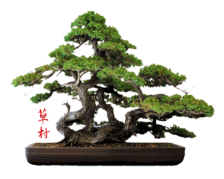Air-Layering Basics
The advantage of air-layering is to reduce the length of a trunk, to grow a better nebari (surface root), to create a large tree quickly, to create a new plant that has exact characteristics of the parent plant. Compared to other propagating techniques, air layering is done above ground while the propagule is still attached to the parent plant. This way of propagating has been practiced for centuries. It requires excessive care and patience. The best time for air layering is spring from March to May. Most cuttings, like maples, are ready by fall, but some cuttings may take two growing seasons to root.
Anatomy of Plant
Under the bark of trees there is a layer of cells called the phloem. This living tissue carries organic nutrients, particularly sucrose to all parts of the plant where needed. Beneath the phloem layer is another layer called the xylem that transports water and mineral nutrients throughout the tree. Beneath the xylem is another xylem layer called the secondary xylem. These xylem layers are thicker and deeper into the wood of the tree than the phloem layer. Lying on top of these layers just under the bark is a layer of actively dividing cells called the cambium.

The Method
There are two techniques to air layer: the tourniquet and the ring method. As the name implies, the tourniquet involves tightly wrapping the branch with copper wire to block the nutrient stream partially. As the trunk grows thicker, the stream of nutrient is restricted further, forcing it to grow roots just above the wire. The ring method involves cutting away a ring of bark. The portion above the ring will have to grow roots immediately to survive. The ring should be large enough to prevent the tree from bridging the gap.
For deciduous trees, air-layering should be carried out in late spring when the first leaves are beginning to harden off. The process of air layering being discussed here is the ring method. Materials needed to perform air-layering include a sharp grafting knife, sphagnum moss, root tone, clear plastic, wire for tying, and gloves for protection. Deciding on where you want roots to develop, assess the amount of space desired between the roots and first branch. Preferably, the first ring cut is just below an old leaf node.
- Make two ring cuts. The distance between two rings should be at least 1 to 2 times the diameter of the branch.
- Peel off the bark from the entire circumference to reveal the cambium layer
- Smear the upper cut with rooting hormone compound
- Wrap in wet sphagnum moss; enclose in a plastic bag, and tie both ends
After Care
The moss should be kept moist at all times. When the bag is filled with mature brown roots, carefully remove the new tree just underneath the new roots. Keep the roots intact with the moss, pot the new plant in fine gravel and potting compost and tie in place to prevent it from rocking and damaging the new roots. Keep the tree in a shady spot and mist regularly until it is established.
See Also
Aggie-Horticulture article on Air-Layering
